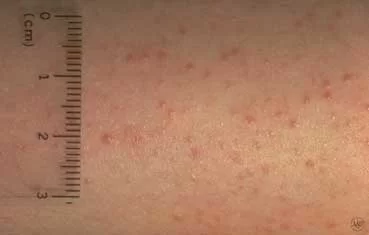Keratosis pilaris (usually called “KP”) is a very common, benign, readily diagnosable condition. The most typical cases present with rough bumps on the posterior arms, anterior thighs, or cheeks, and frequently occurs in individuals or families with atopy (e.g. atopic dermatitis/eczema, seasonal allergies, food allergies).


The latin name is appropriate. Keratosis refers to the protein keratin (which reinforces hair, skin, and nails) while “pilaris” refers to the involvement of hair follicles. Microscopically, KP shows keratin plugs within the follicular openings of the skin. Visually, the consistent spacing of the bumps is a clue that this is a disorder of hair follicles, which tend to be very evenly distributed, just like hair follicles.
KP can range in severity and distribution, and can sometimes become red and inflamed. It can sometimes present or worsen during pregnancy and can be more persistent and extensive in patients with Down syndrome. Occasionally, inflammation/redness can lead to itching (prompting treatment with topical corticosteroids), or the roughness can be bothersome (prompting treatments with keratolytics like salicylic acid or ammonium lactate). In either case, treatment can be frustrating because the keratin is constantly being regenerated by the follicles, so even effective therapies require consistent use. Fortunately, most cases are mild, the severity of gradually decreases with time, and so treatment is usually optional.
